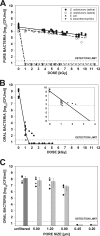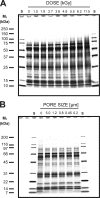Integrity of proteins in human saliva after sterilization by gamma irradiation
- PMID: 21148692
- PMCID: PMC3028710
- DOI: 10.1128/AEM.01374-10
Integrity of proteins in human saliva after sterilization by gamma irradiation
Abstract
Microbial contamination of whole human saliva is unwanted for certain in vitro applications, e.g., when utilizing it as a growth substratum for biofilm experiments. The aim of this investigation was to test gamma irradiation for its suitability to sterilize saliva and to investigate the treatment's influence on the composition and integrity of salivary proteins in comparison to filter sterilization. For inhibition of bacterial growth by gamma irradiation, a sterility assurance level of 10(-6) was determined to be reached at a dose of 3.5 kGy. At this dose, the integrity of proteins, as measured by fluorescence, circular dichroism, and gel electrophoretic banding pattern, and the enzymatic activities of salivary amylase and lysozyme were virtually unchanged. Filtration reduced the total protein concentration to about half of its original value and decreased lysozyme activity to about 10%. It can be concluded that irradiation is suitable for sterilizing whole saliva in its native form.
Figures



References
-
- Aguirre, A., M. J. Levine, R. E. Cohen, and L. A. Tabak. 1987. Immunochemical quantitation of alpha-amylase and secretory IgA in parotid saliva from people of various ages. Arch. Oral Biol. 32:297-301. - PubMed
-
- Busscher, H. J., M. Rinastiti, W. Siswomihardjo, and H. C. van der Mei. 2010. Biofilm formation on dental restorative and implant materials. J. Dent. Res. 89:657-665. - PubMed
-
- De Jong, M. H., and J. S. Van der Hoeven. 1987. The growth of oral bacteria on saliva. J. Dent. Res. 66:498-505. - PubMed
Publication types
MeSH terms
Substances
Grants and funding
LinkOut - more resources
Full Text Sources
Other Literature Sources
Molecular Biology Databases

